The idea of a “birthday party” in a monastery would, probably, not excite most people: right? Yet, if there are any Orthodox Christian monasteries that can be described as “joyful, welcoming and fun to visit,” the community of Monks and Nuns of New Skete in Upstate New York would definitely be one of them. And this was my ultimate choice to visit and celebrate birthday in late May of 2023. Would you like to know how ancient worship practices, elaborated iconography, German shepherds and cheesecakes may be related to each other? If yes, then keep reading this story.
Geographically, the New Skete monastery is near town of Cambridge, NY, about forty-five miles northeast of Albany, and close to the Vermont border.
Located on the eastern edge of the gentle Taconic Mountains, with rolling hills and dense forest, the area surrounding New Skete has an immense natural appeal: especially, in the fall, when the foliage turns into bright gold and red colors.

What does “New Skete” mean? In Eastern Christianity, the word “skete” refers to a monastic community existing in a relative isolation from the outside world, but, at the same time, allowing for communal worship services and mutual support of its members through the shared resources. And this definition is very fitting for the the Monks and Nuns of New Skete who are two separate but closely affiliated monastic communities and situated just a couple of miles apart.

New Skete was founded by former Catholic monks and nuns. In 1966, twelve Franciscan monks separated from their monastery in New Canaan, Connecticut, and established a new monastic brotherhood. Their goal was to live a spiritually fuller monastic life which they found within the Eastern Christian (i.e., “Orthodox”) tradition. The community of the Nuns of New Skete was formed in 1969, when seven Catholic nuns from Indiana came to Cambridge, New York, and—with the help of the Monks of New Skete who had already settled there—built their own monastery. These nuns left Poor Clares Order because they felt that this order’s strong emphasis on the cloistered living (i.e., the life that is fully disconnected from the outside world) was out of date and did not correspond with their vision for the mission of an American monasticism. In 1979, after years of studying Orthodox theology and practicing Orthodox liturgical worship services, the Monks and Nuns of New Skete joined the Orthodox Church in America.
The first monastery’s church, Holy Transfiguration Temple, was built in 1969 in a classic Slavic style. With rough-hewn exterior and gold-leafed onion-like cupolas, it is reminiscent of village churches in Northern Russia or Finland.

As the time went by, New Skete began attracting more day visitors and those seeking multi-day spiritual retreats. A bigger church was needed, and in 1983 the Holy Wisdom Temple was added to monastic complex. Unlike Holy Transfiguration, it was built in a basilica style, in the Greek Byzantine architectural tradition. Both churches have richly decorated interiors with icons, mural paintings, and many hand-carved elements out of variety of woods including walnut, zebra, ash, cedar and English oak.
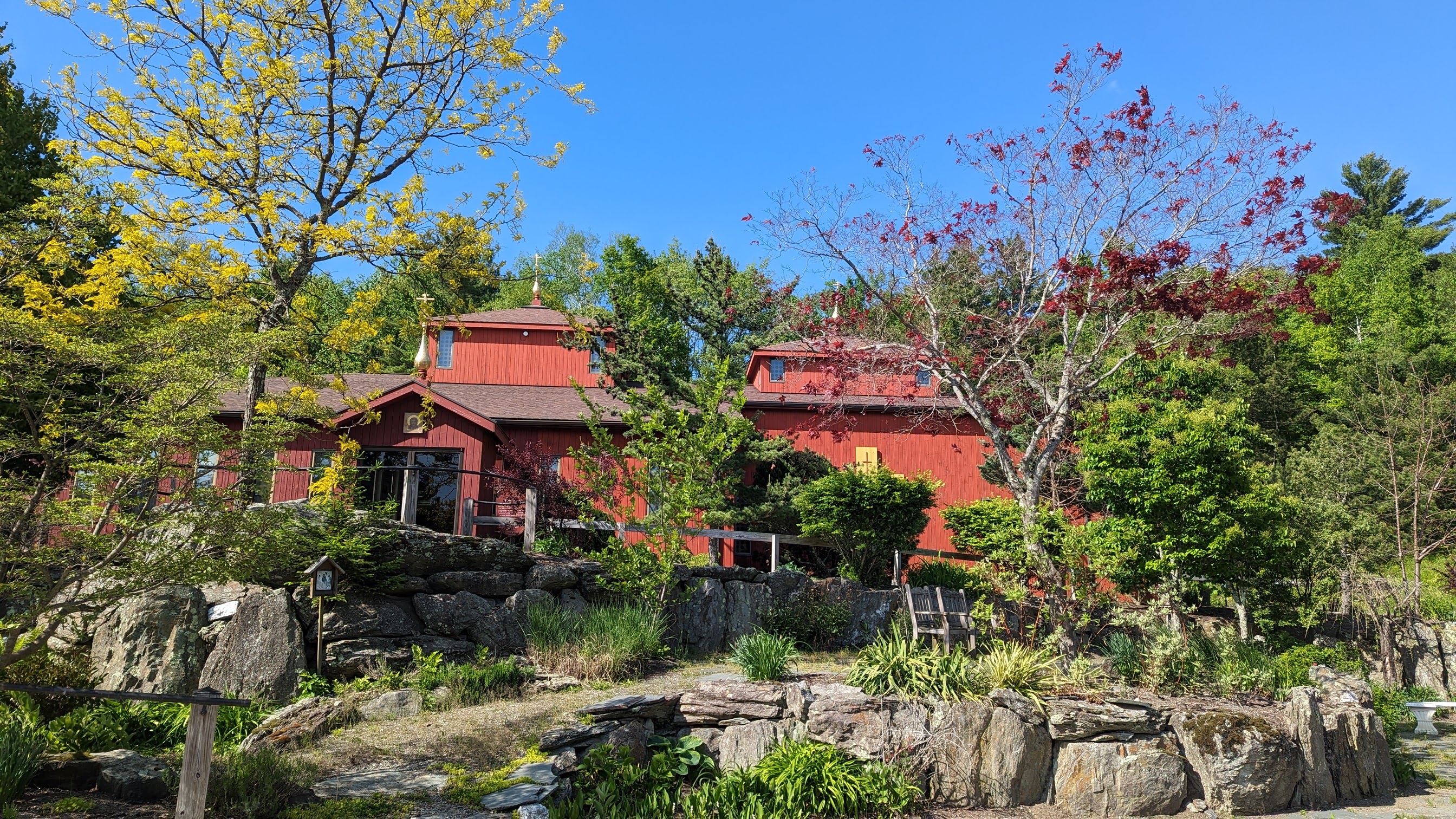
Elaborate bell-tolling is essential for Orthodox Christian worship services, and the wooden bell-tower was eventually constructed. Its design was inspired by the bell towers of the Carpathian Mountains in Eastern Europe. Through the day, fifteen different bells announce – with distinct rhythms and sounds – the times of worship, or accompany certain moments in prayer services.

The monks and nuns of the New Skete is a monastic community, but in many ways it is very different from the other monasteries. The prime distinction is that they see their mission in leading spiritual life and sharing their faith with the others in the manner that fits with modern American culture. This is true about their worship practices, their rather unique monastic “businesses” (remember, I mentioned dogs and cheese-cakes!), and, most importantly, their hospitality and openness to visitors of any religious background.
Those who are familiar with Orthodox Christian worship services and the appearance of the church will find here a number of distinct elements, all of which serve the same goal: to make the religious experience more meaningful, engaging and participatory for anyone. In doing so the community of the New Skete takes inspiration form the early Christian Church because these were the times when religious services were more immediate and understandable to ordinary people.
Sometimes, Sunday Liturgy begins with the gathering of monks, nuns, and laypeople outside the church, and everyone then enters jointly. Most of the services are conducted not from the altar area but from the middle of the church, so that the clergy, monks, and nuns are surrounded by the laypeople.

When it is time to venerate icons or to kiss the cross, there is no particular order as to who comes first, whereas more traditional practice would be: clergy, followed by the non-ordained monks, followed by nuns, followed by the laity. The altar is “open” (i.e., the iconostasis does not form a wall) so that everyone can see what happens inside (as was the iconostasis of the ancient Hagia Sophia church in Constantinople).

The walls of the monastery’s main church are painted with iconographic portraits of both Eastern and Western saints of the early undivided Church, and also with portraits of prominent Christians who are not recognized as saints (including Fr. Alexander Men, Patriarch Athenagoras, Pope Paul VI, Archbishop Michael Ramsey, Dorothy Day, and Mother Teresa of Calcutta). However, the latter are depicted without halos.

If you are looking for a good Orthodox Church music experience, the New Skete is also a place to be, as its choir practices regularly and accompanies all services.

The internal governance of the Monks and Nuns of New Skete is also distinct from the other Orthodox monasteries. Both communities elect their priors (abbot, abbess) for a six-year term and emphasize an equality between nuns and monks in their everyday lives, and administration. All significant decisions are made by the “synaxis”: the gathering of all members of both communities. If a person wishes to join the New Skete, the candidacy of a prospective new member should be approved by all monks and nuns.
The New Skete gained a considerable national and international fame through the quite unique Dog Training Program and German Shepherd Breeding Program. People interested in the training of their dogs can apply online, then bring and leave them with monks for two and half weeks. The monks’ philosophy and methods of “educating” the dogs are described in several bestselling books published by the New Skete: How to Be Your Dog’s Best Friend, The Art of Raising a Puppy, Let Dogs Be Dogs. Check them out on Amazon.

The monks’ dog training series, “Divine Canine,” was aired on the Discovery Channel’s Animal Planet.

Fr. Christopher, New Skete’s current abbot is also a head trainer. He told me: “We mostly work with dogs who, for various reasons, do not behave well. When we work with a dog, the focus is on building quality relations between the dog and its owner. Our goal is not to ‘train,’ but to achieve a transformed relationship between the owner and a dog.”
“Our philosophy – he continued – is threefold. First, a good owner needs to be a benevolent leader. Second, a good owner should understand what his or her dog’s particular needs are. Third, in order to stop a dog’s bad behavior, you need to replace it with good behavior. How we do this? Pretty much like with children: we provide dogs with a healthy and positively structured environment. Partially, this is done through food-based rewards, but there are many other tools as well. Most importantly, our ‘training’ is not only for dogs. When the owners come back to pick up their dogs, we carefully explain what they should (or should not) do, if they want to have lasting results.”

The history of the German Shepherd Breeding Program is an interesting one. When monks first moved into their present location, one of them brought a German shepherd named Kyr. The community’s first years were a time of hardships and uncertainties, but the brothers noted that the presence of Kyr had an extremely unburdening and relaxing impact on them. When Kyr died, they bought as a replacement two purebred German shepherds, Becky and Jessie. Then the monks decided to try to supplement their meager income with the selling of puppies. The first attempt was unexpectedly successful: the buyers (mostly locals) loved an idea of getting a puppy who was born and spent first weeks of its life at a monastery.

There is a twist in how the raising and training of the German Shepherds is done. Each monk cares for a particular dog (or two, or three), who lives with and recognizes him as an owner. As a result, a strong personal bond is formed between a dog and a monk. A certain philosophy stands behind such an approach. The realities of monastic life present a potential danger of an excessive focus on oneself. The presence of a dog in each brother’s life helps to deal this danger. As Fr. Christopher says, “The dogs are mirrors of our emotional state and behavior. One of the human weaknesses is that oftentimes we don’t pay attention to how we behave, but the dogs allow us to have better self-reflection. Working and living with dogs help us to be better monastics.”

Even if you are not interested in dog’s training or buying a puppy (the price-tag is $ 5,000), it is simply great fun to see these – very well behaved – German Shepherds. And if you are lucky, the monks may invite you to join them on walking with dogs in surrounding woods.
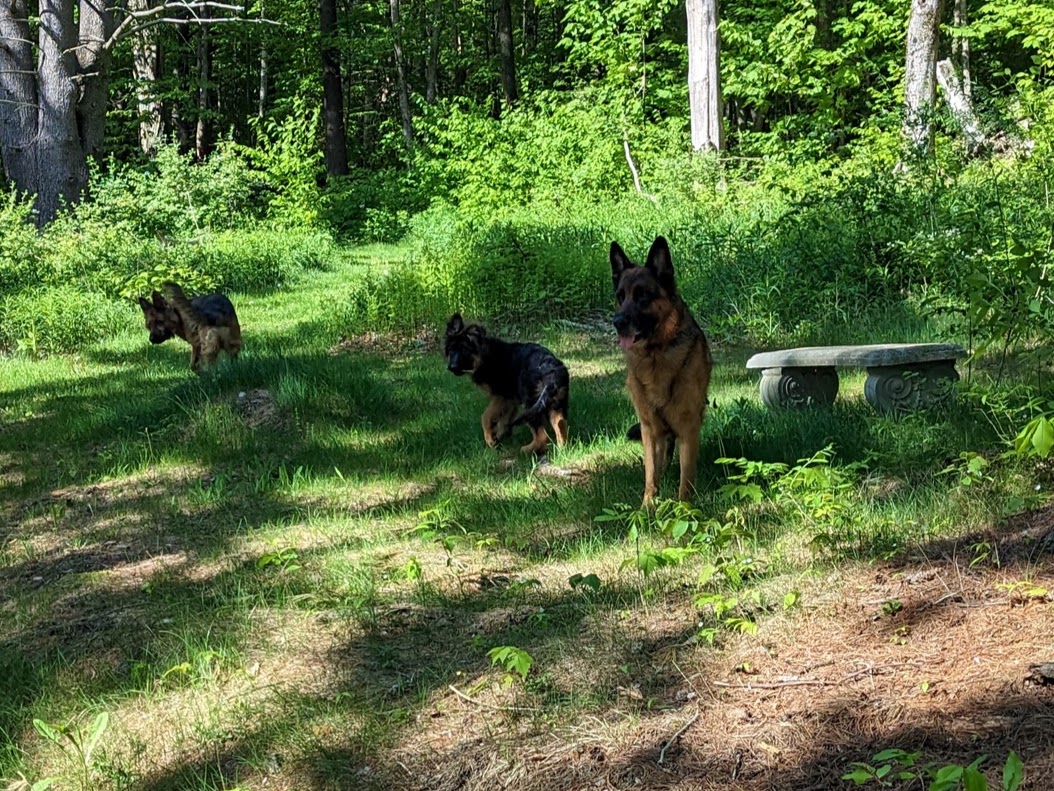

Speaking of “walking in the woods,” the New Skete is surrounded by gorgeous forest. Over the years, the monks have created miles of well sign-posted nature trails around the monastery. Hence, while visiting New Skete, there is no need to worry about getting a good daily portion of exercise. Go for a hike on one of these trails and enjoy solitude and nature!

An interesting connection exists between the New Skete’s “dog industry” and its religious outreach. People of all religious backgrounds come to the monastery for the Dog Training or German Shepherd Programs, or simply to watch the animals. The monks always invite visitors to see New Skete’s richly decorated churches and meditation gardens. Some of the visitors stay for worship services and eventually return becoming good friends of the monastery, while some even join the Orthodox Church.
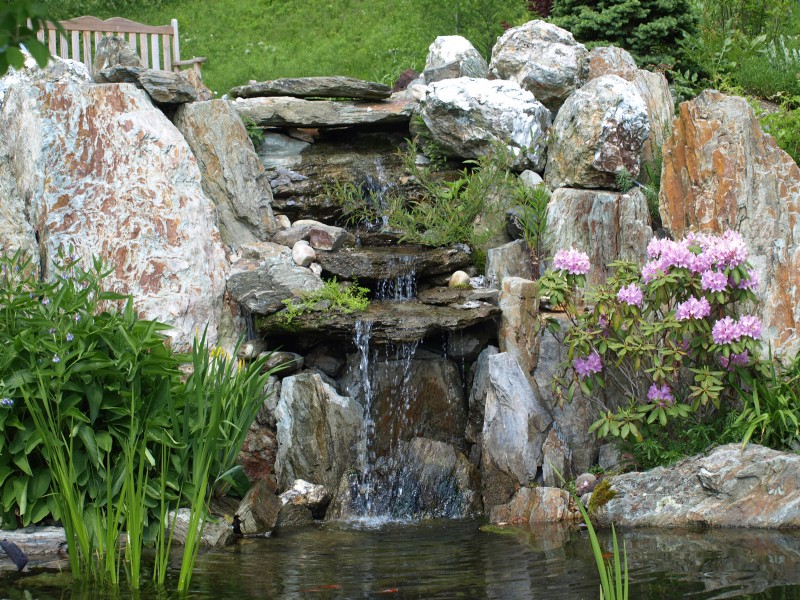
The New Skete’s connection to animals is not limited to dog’s programs. One of the highlights in the monastery’s life is the annual celebration of the Blessing of the Animals. It is held in the autumn, on a weekend closest to the Feast of St. Francis (October 4), the saint who is regarded as the patron saint of animals. Blessing of the Animals is dedicated to spiritual connection between human beings and God’s creatures. Everyone is invited to come and to bring any pet (or its picture) for the special outdoor church service, and blessing with holy water.

Blessing of the Animals festival is accompanied by a short presentation on the history and life of the New Skete communities. Adults and children alike love this event, when, for a day, the monastery’s grounds transform into a small zoo with animals ranging from horses to a rock python (and also lots of resident frogs who pipe up for the occasion).
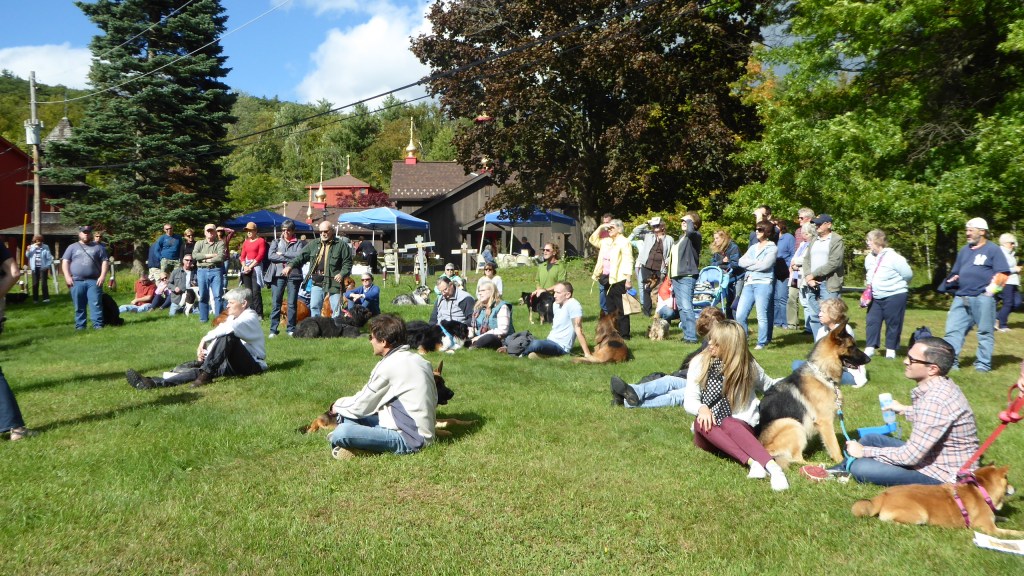

Besides dogs, there is another “industry” which made New Skete well known to the outside secular world. The Nuns of the New Skete created a line of the gourmet products under the brand “New Skete Kitchens.”

How creation of the gourmet foods fits into monastic living? Very simple. One of the sisters explained to me: “Our monastic life is about striving for quality in ALL we do. And so, you can be proud to offer our gourmet products on your menu.”
Among these products, the variety of exquisite cheesecakes gained genuine nationwide recognition. These cheesecakes are offered in 17 flavors. My personal favorites are apple walnut (made in fall and winter only), orange cream (summer only), and amaretto cream.
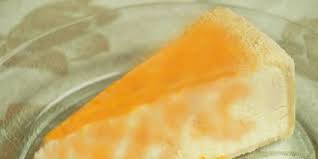
Another bestselling item are fruitcakes. The nuns restored an old British recipe that called for aging the cake. Unusually moist and aromatic, full of brandy-soaked dried fruits and nuts, the fruitcakes are typically fully sold-out before Christmas.

How to sample or purchase these mouth watering products? Everything can be ordered online HERE and shipped nationwide (including overnight delivery).
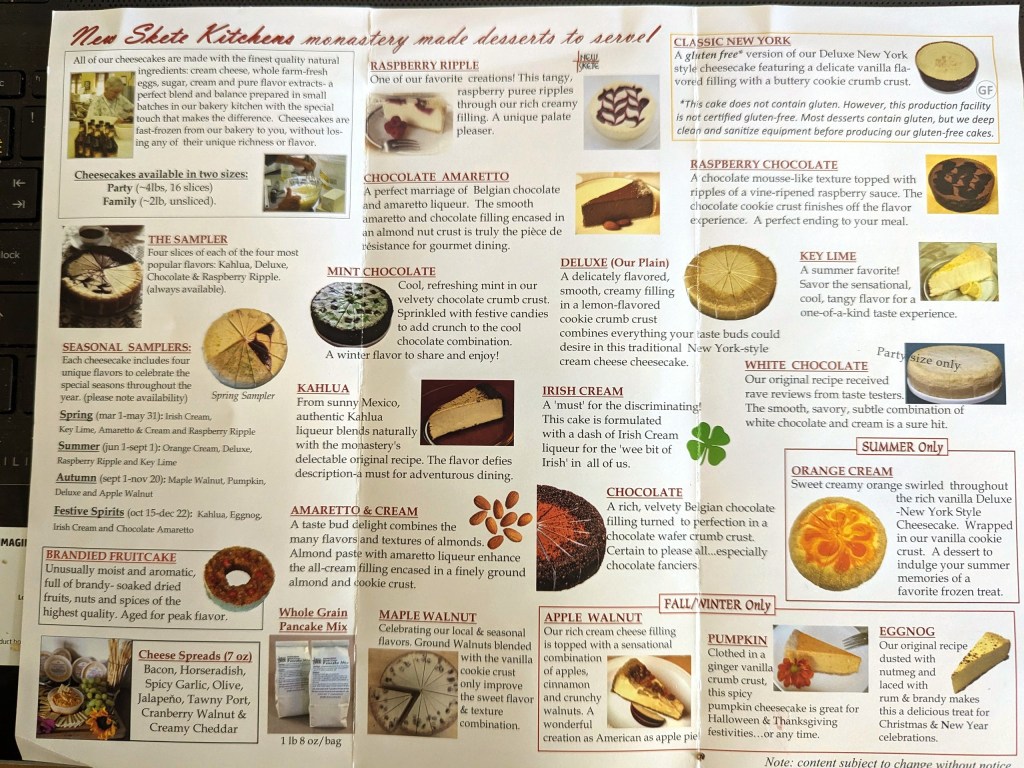
To me, however, the best option is to visit nuns in person. Approaching their house (about three miles from the Monks of New Skete), you will see this sign.

Then you can enter their gift shop (open 12.30 to 4 pm, Tuesday-Saturday) and wander around.

The major “treasure” – the cheesecakes – are in a refrigerator. Open it, look at variety, make your choice, and take whatever appeals to you. It is an “honesty payment” system: you can put your money or checks in the payment box.

However, the entire point of coming in-person is to meet the nuns. Then you will have a chance to talk with them and may hear a lot of great stories about New Skete and their lives (but I strongly suggest to make appointment in advance). Some of these stories are lighthearted and humorous. Like, for example, a memorable but rather disastrous event known as “Chocolate Niagara Falls.” What happened on that day was a mistake in the baking process resulting in melting of more than 100 chocolate cheesecakes which literally flooded the kitchen.
But most people come here for a different type of conversation – a conversation which will inspire them to become a better person or help with much needed self-reflection. During my visit, I sat to talk with Sister Rebecca. Whatever I planned to discuss, never came into conversation. Instead, I listened spellbound to captivating story of her life and spiritual journey. About growing up during WWII in a military family, moving to post-war Guam and getting to know there many Japanese POW, then moving to Philippines and witnessing enormous poverty and post-war devastation, experiencing spiritual awakening through realization that the life is not limited to what we see with our eyes and the internal beauty of human beings is much more important, joining the Poor Clares monastic order in Canada, going on her first mission trip to Hongkong and teaching there English to children for ten years, transferring to Epiphany monastery in Southern France and laboring for five years hard manual work in vineyards along with mostly Arabs from former French colonies, discovering the beauty of the Eastern Christian worship services and studying for seven years the art of painting icons. When after decades abroad she returned to the U.S. in 1987, the New Skete was a very natural place for Sister Rebecca to join. That is, to join a community with strong focus on Eastern Christian tradition of spirituality and worship, but, at the same time, open to change and cultural diversity.

You can still see Sister Rebecca helping humbly in New Skete’s bakery, but she spends most of her time counseling people, and offering them spiritual advice and encouragement.
To make it clear, the dogs-related programs by the monks and flourishing cheesecakes business of the nuns are important for the New Skete’s economy. They also help to attract more people to New Skete many of whom would otherwise never encounter Eastern Christianity. Further, some of these visitors return later to learn more about Orthodox Church and join worship services.
Yet, dogs and cheesecakes asides, the monks and nuns of New Skete focus on many other things which are at the heart of the Orthodox Christianity. Two sisters are talented iconographers and paint icons for individuals and churches. Upon entering nuns’ house, most visitors are impressed with the icon of the Holy Trinity painted by Sister Cecilia, the abbess of nuns’ community.

The often asked question – “What is the meaning of this icon?” – helps to switch conversation from a more mundane subjects (dogs, cheesecakes) to Christian teachings, to the story of the 14th century monk Andrei Rublev (who painted the original Holy Trinity icon), and his interpretation of the episode narrated in the Book of Genesis (the story of Sarah and Abraham welcoming three mysterious guests).
Similarly, besides their dogs’ literature, the monks of New Skete authored a book on spirituality from a monastic perspective (In the Spirit of Happiness) and a popular series on meditations in everyday life (Rise Up with a Listening Heart).

To make it clear, New Skete has a strong commitment to living the monastic life in a manner appropriate for the 21st century, but, at the same time, remains a monastery in all basic senses of this word. Prayer is at the heart of life here, and everyone gathers for daily Matins (morning) and Vespers (evening) services, as well as the Divine Liturgies on Sundays and feast days. Living as a monastic means embracing willingly a discipline when personal desires and preferences are secondary compared to communal needs and rules. Also, a very important quality for an individual considering monastic life is the desire to seek God by embracing a life of ongoing self-transformation. And this requires simultaneously discipline, desire to learn and change oneself.
Does such a life attract many candidates to join New Skete? During my visit, I met there three men who were in different stages of either simply exploring the way of living in a monastery or making already steps towards becoming a monk and a member of the New Skete. We went together on a hike and talked about their lives and motives to come to New Skete.

One of them was an accomplished medical professional, another worked in highly responsible administrative position, while the third conducted substantial research for Google dealing with neuroscience and artificial intelligence. All very different people, but all came to New Skete for the same reason. Beneath the anxious daily demands and social stereotypes that often define our identity, they experienced a deeper pull, one devoted to searching for something more essential.
Whether they will stay and become full-fledged members of the community remains to be seen, but luckily the New Skete has two structured programs which help a person to discern how deep his/her call for monastic vocation is. One is for those who already made a decision to become a monk or nun. You can read about it HERE.

The second – called “Resident Experience” – is for those who may not think of becoming a monastic, but want to experience the way of living in a monastery by participating fully in the daily rhythm of prayer, worship, work, study and leisure. You can read about it HERE.
For those who – like me – simply wish to spend a few days in nature, surrounded by peace and quiet, the New Skete offers the very comfortable Emmaus Guesthouse. People of all religious backgrounds (or without any religion) are welcome and can stay there. This wide open hospitality is seen by monks and nuns as part of their monastic vocation. Brother Luke explained to me: “Our vocation as monastics is to offer a place of quiet and prayer to anyone who comes. We hope that visitors and guests may experience some of God’s healing in their lives through our life in community. Monks of the Christian East have always welcomed visitors and offered spiritual guidance to those who seek it. We hope that others might see by the way we live that some aspects of the monastic way can be life-giving in their lives too.”
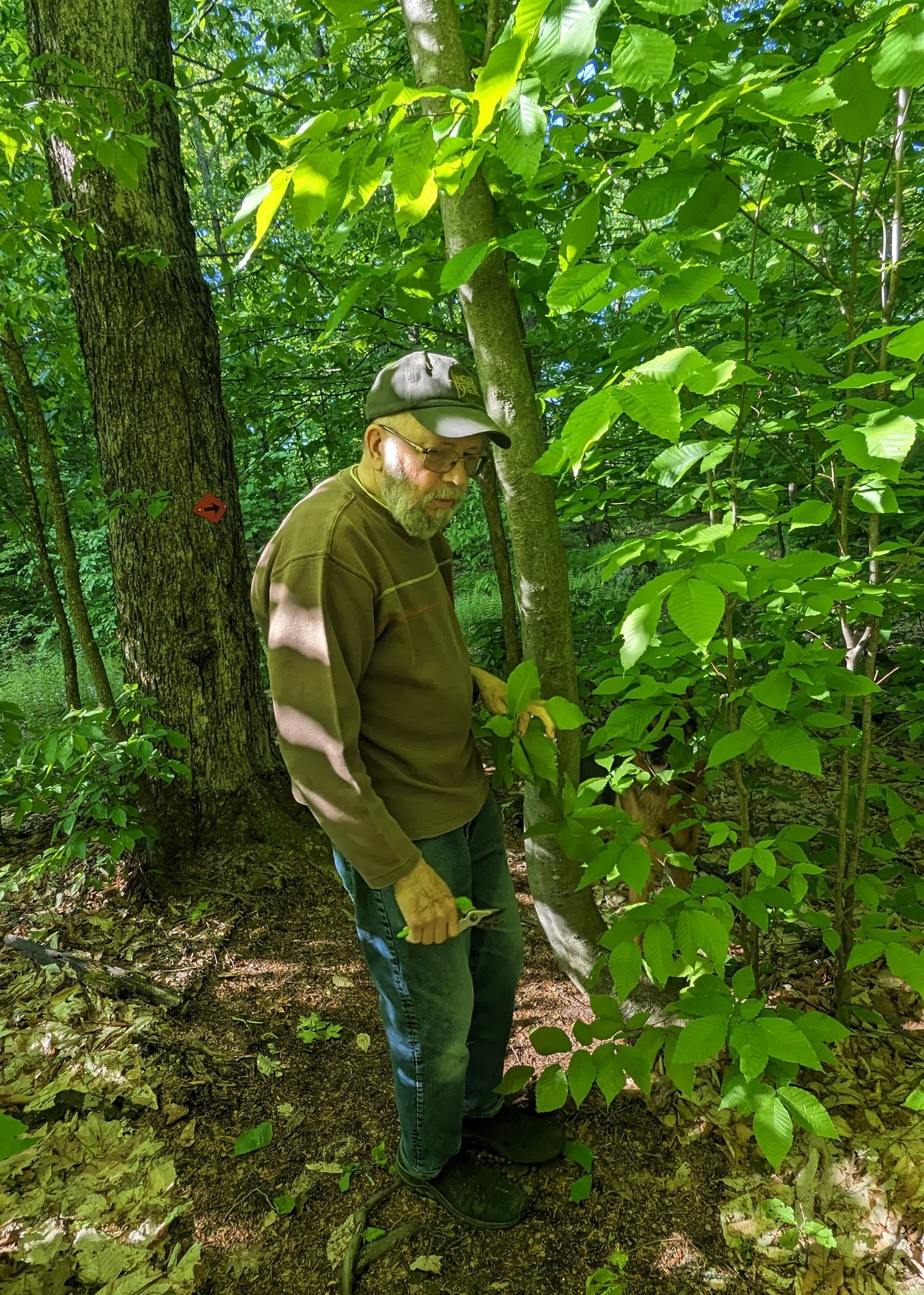
The Emmaus guesthouse is about half-mile away from the main monastery’s complex and is surrounded by woods with many hiking trails.

The guesthouse has a large communal kitchen, a spacious communal sitting area, a library, and several en-suite accommodations. Each has a bedroom and a small living room with glass sliding doors, thus, allowing guests to step out “straight into nature” and sit on the outside porch.
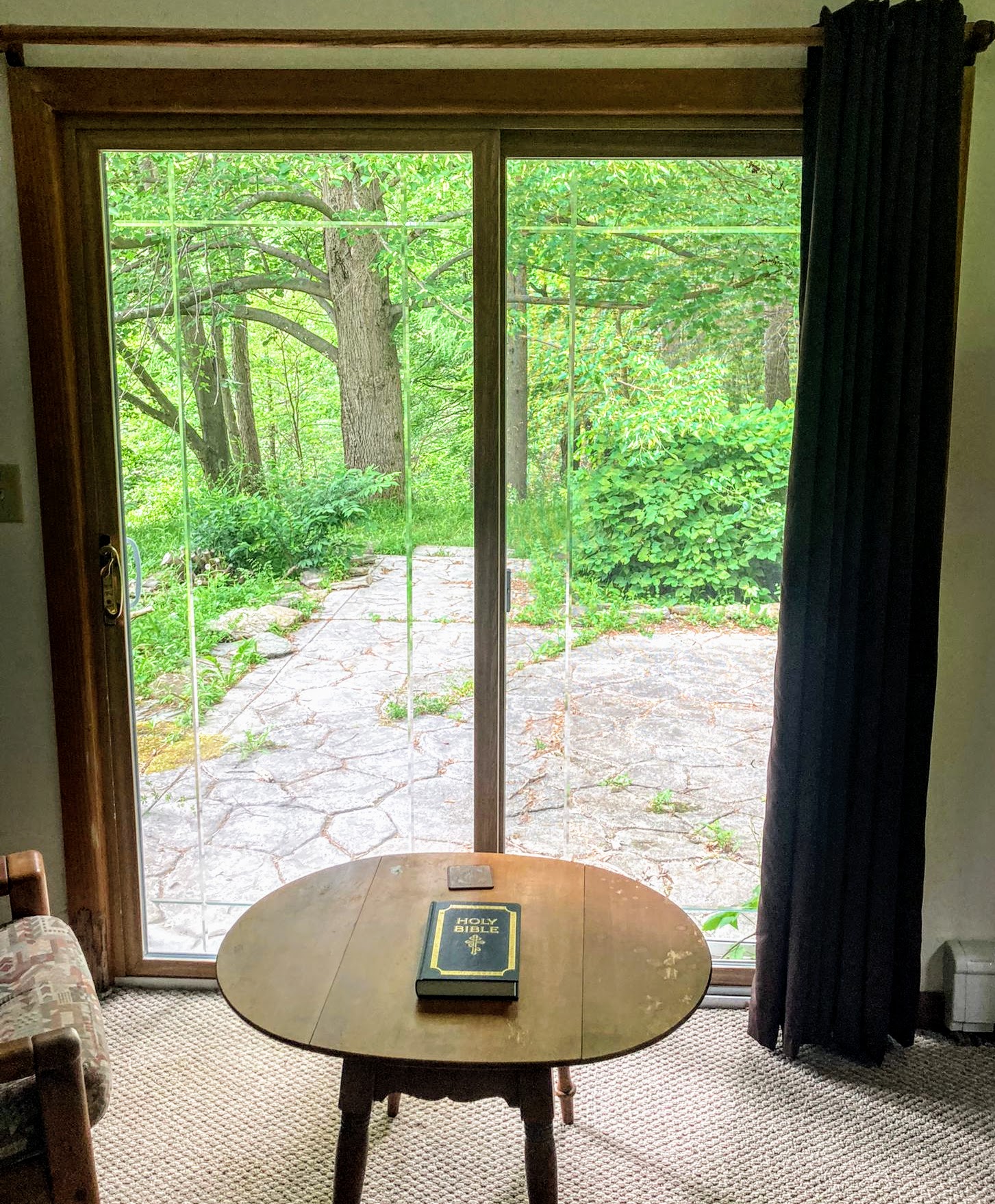
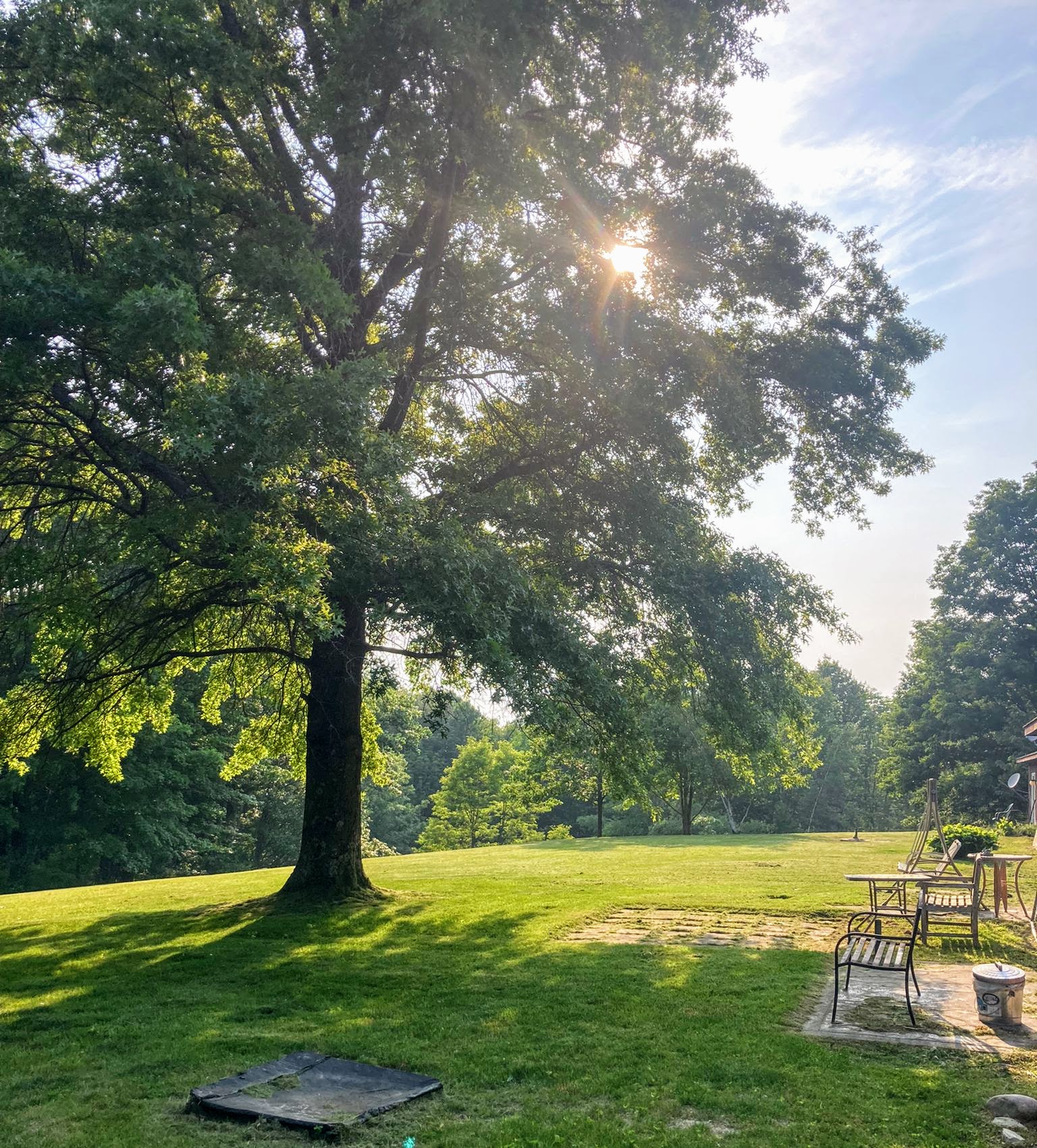
Usually all guests are invited not only to worship services, but also share meals together with monks and nuns. These communal lunches and dinners are great opportunity to get to know the members of the New Skete community and to ask all possible questions. And, by the way, while not a Michelin restaurant, the food at the New Skete is diverse and abundant. The meals are home-cooked, served in buffet-style and with several choices in order to accommodate various dietary restrictions.

If you decide to come for an overnight visit, make sure to reserve a room in advance. Write New Skete’s guestmaster, Brother Gregory (brgregory@newskete.org) and tell him if you have any additional needs.
As you can imagine, the New Skete attracts visitors from “all walks of the life.” Among those who stayed for several days was Jesse Itzler, an entrepreneur, writer, rapper, and co-owner of the NBA’s Atlanta Hawks. The result of his stay at New Skete was a book: Living With the Monks: What Turning Off My Phone Taught Me about Happiness, Gratitude, and Focus

My last day at New Skete was Monday, when the monastery is closed for visitors so that monks and nuns can have a day of undisturbed private time. But I was given a special permission to stay (perhaps, as a birthday present?) and decided to use this day to explore the area outside of the New Skete.
There are plenty of interesting destinations within easy driving distance from the New Skete which would satisfy people with various interests: Hoosick Falls (a historic town and waterfalls), great short hikes to gorgeous Dionondahowa and Lye Brook Falls (Google it!), a place called the “Ice Cream Man” (an ice-cream shop offering huge variety of ice-creams which is set in a pine forest with picnic tables), the Hand Melon Farm (a place, where you can pick various fruits and berries and their famous hand melons), many bucolic and scenic villages and towns across the state borders in Vermont (Manchester, Dorset, Bennington), and much more.

My choice was a place called Merck Forest – a combination of forest and several working farms, which offers visitors 30 miles of hiking trails, rustic cabins to stay in the woods, possibility to see the farms and learn about farming. One of the hikes leads to the top of Mount Antone: it us about 5 miles round-trip, but also with possibility to take some additional short side-hikes. This option looked good for me and the trail was really great. First, you will see some bucolic farmlands.
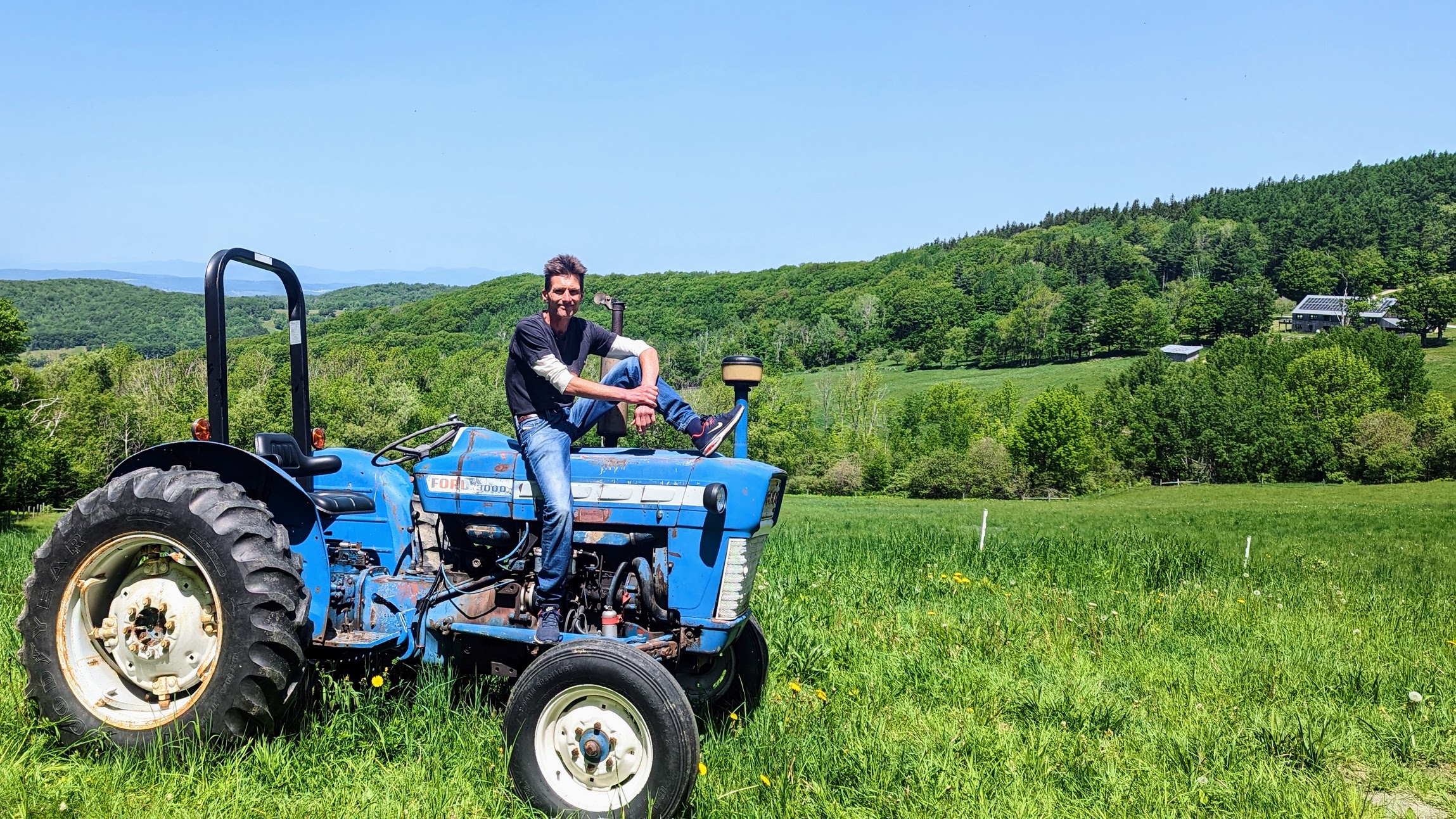
Then you will hike in a gorgeous forest.
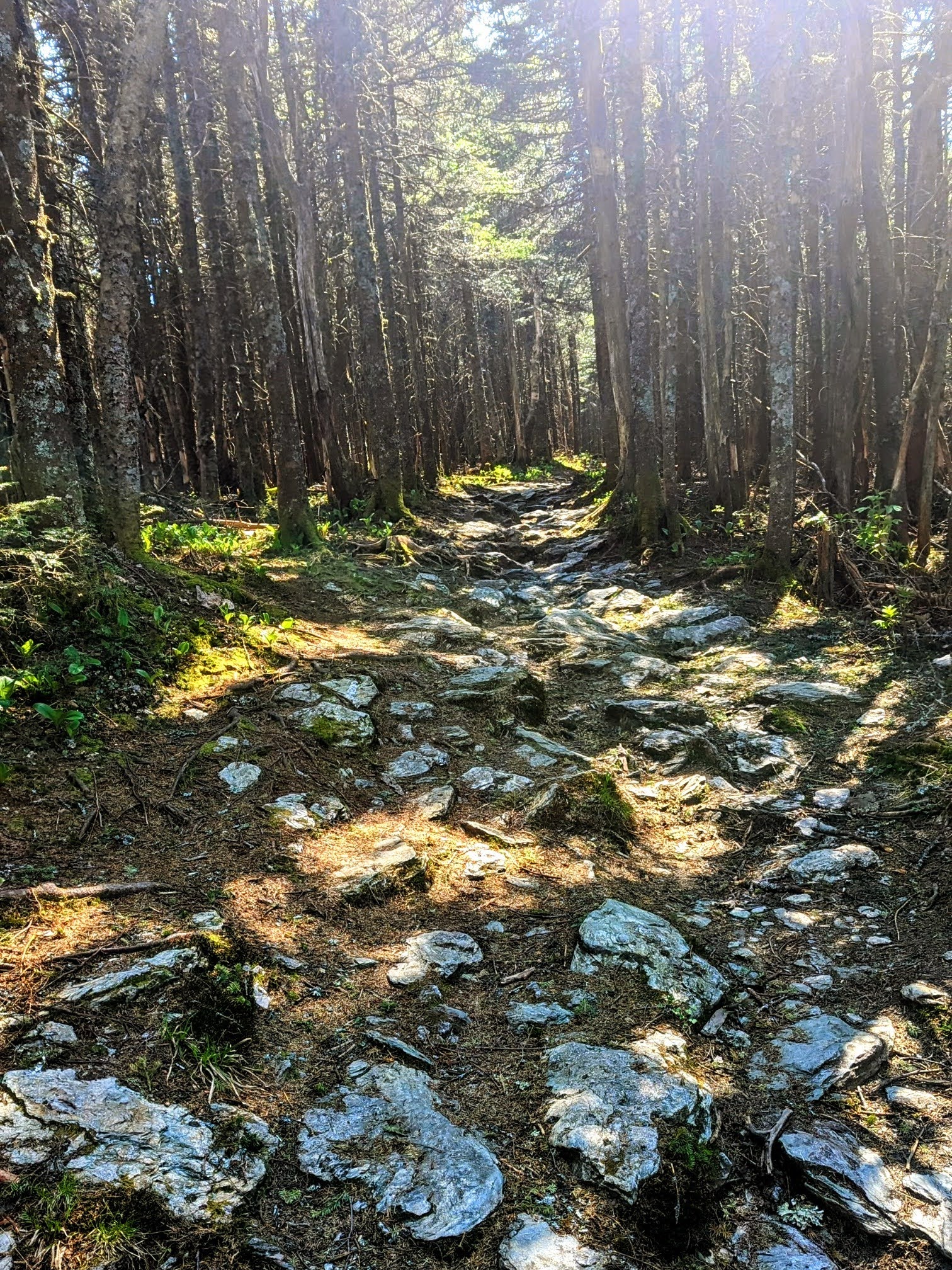
Along the road, you can check out several rustic cabins and decide if you would want to stay overnight.

The real highlight of the hike is, of course, the panoramic view from the top of Mount Antone.

I stayed on the top of Mount Antone for a while, and I was not alone there. Vlad, one of the prospective candidates for monastic vocation at the New Skete, has joined me on this hike. We had a “”picnic with the view” and talked about our previous lives and future plans.

It was clear that the two of us are – in many ways – very different people, but we enjoyed each other’s company and learned from each other’s experiences. When we began our descent back to the car, I reflected on this conversation. I thought that it is thanks to New Skete that people from the different walks of life and of diverse cultural backgrounds can encounter each other, share their thoughts, learn, and enrich their experiences – all these leading to their further transformation.
And I also thought that this is very fitting with the New Skete’s mission statement:
“Through prayer, worship and the work of our hands, we seek to respond to the mystery of God and to the Gospel’s power to transform human living. Welcoming all, we seek to bridge the old with the new and to witness to the sacredness of all creation.”




Dear in Chris Alexei,
Unsubscribe.
Also, forgive me, I never remember subscribing. You didn’t use your massive email list to sign all of us up to your personal blog, did you?
Humbly in Christ, fg
LikeLike